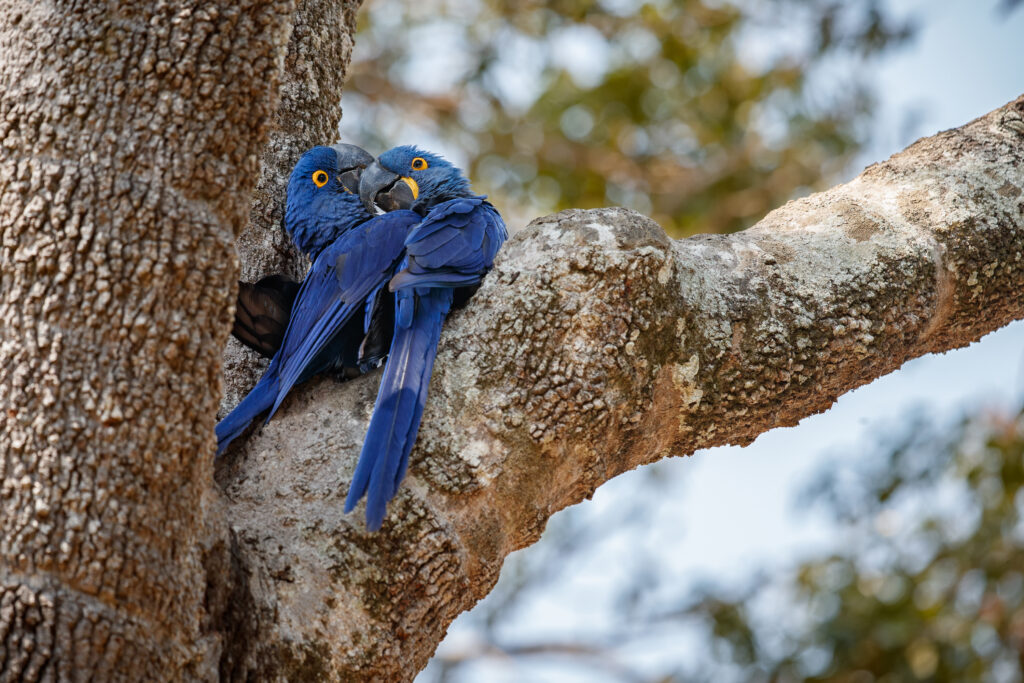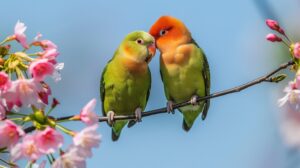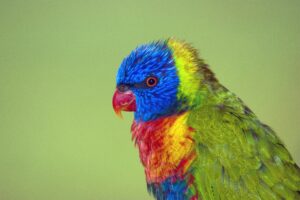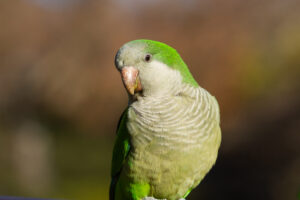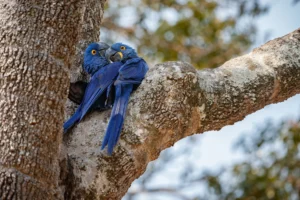Introduction
When it comes to pet birds, few captivate the heart quite like the vibrant blue lovebird. These diminutive parrots have soared in popularity among bird enthusiasts across the United States, and for good reason. The blue lovebird, with its striking azure plumage and charismatic personality, represents one of the most fascinating color mutations in the avian world. Whether you’re a seasoned bird keeper or simply curious about these colorful companions, there’s much more to blue lovebirds than meets the eye.
Many people are familiar with the classic green lovebirds, but the blue lovebird mutation has created quite a stir in avian circles. These eye-catching birds aren’t just beautiful to look at—they possess unique characteristics and fascinating origins that might surprise even experienced bird owners. The blue lovebird’s distinct coloration isn’t just a matter of aesthetics; it represents generations of careful breeding and a deep understanding of avian genetics.
In this comprehensive guide, we’ll explore four shocking facts about blue lovebirds that most people don’t know. From their genetic background to their special care requirements, blue lovebird behavior particularities, and their value in the avian market, this article covers everything you need to understand about these captivating blue beauties. We’ll delve into blue lovebird care essentials, discuss blue lovebird price considerations, and reveal what makes blue lovebird breeding so fascinating to enthusiasts worldwide.
So, whether you’re considering adding a blue lovebird to your family or simply want to expand your knowledge about these remarkable creatures, prepare to be amazed by these little blue wonders of the avian world.

Fact 1: Blue Lovebirds Aren’t Naturally Blue in the Wild
One of the most startling facts about blue lovebirds is that they don’t actually exist in the wild in their blue form. The blue lovebird mutation is entirely the result of selective breeding in captivity. This revelation often surprises many bird enthusiasts who assume that all colorful birds derive their hues from natural selection.
The Genetic Story Behind Blue Lovebirds
The blue lovebird is primarily derived from the peach-faced lovebird (Agapornis roseicollis), which in its natural state displays green as its predominant color. The journey from green to blue involves fascinating genetic principles. The blue coloration in blue lovebirds is the result of a recessive gene mutation that affects how the bird’s feathers reflect light.
In scientific terms, the blue lovebird mutation occurs due to the absence of yellow pigment (psittacin) in the feathers, while the structural blue coloration remains intact. This genetic modification means that areas that would normally appear green (a combination of yellow pigment and structural blue) now appear as a pure blue color. The genetic basis for this mutation has fascinated avian researchers for decades and continues to be studied extensively.
Different blue lovebird mutation types exist, ranging from cobalt blue to turquoise and violet-factor blue lovebirds. Each variation results from slightly different genetic combinations, creating a spectrum of blue shades that breeders can selectively enhance through careful pairing.
Historical Development of Blue Lovebirds
The blue lovebird mutation first appeared in captive-bred lovebirds in the mid-20th century. Since then, dedicated breeders have worked to stabilize and enhance the blue coloration through selective breeding programs. The blue masked lovebird, a particularly popular variety, combines the blue mutation with the distinctive facial patterns of the masked lovebird species (Agapornis personatus).
The origin of blue lovebirds as we know them today can be traced back to European breeders who first documented and began selectively breeding for this mutation. Since then, the blue lovebird has become a globally recognized and sought-after variety, with specialized breeding programs dedicated to producing birds with the most vibrant and consistent blue coloration.
Today’s blue lovebird characteristics are the result of decades of careful breeding to strengthen the expression of the blue genes while maintaining the overall health and vigor of the birds. This delicate balance between color enhancement and physiological well-being represents one of the greatest achievements in ornithological breeding.
Fact 2: Blue Lovebirds Require Special Care Considerations
While many assume that all lovebirds have identical care requirements, blue lovebirds actually have some special needs that distinguish them from their green cousins. These particular care considerations stem from the genetic modifications that create their stunning blue plumage.
Unique Dietary Needs of Blue Lovebirds
The blue lovebird diet requires careful attention to ensure optimal health and color maintenance. Due to their genetic makeup, blue lovebirds may process certain nutrients differently than standard green lovebirds. Specifically, blue lovebirds often benefit from diets rich in certain amino acids and proteins that support healthy feather development.
A balanced blue lovebird diet typically includes:
- High-quality pellet mix specially formulated for lovebirds (40-50% of diet)
- Fresh vegetables with emphasis on leafy greens (30-35% of diet)
- Limited fruits to avoid excess sugar (10-15% of diet)
- Specialized seed mixes as occasional treats (5-10% of diet)
- Calcium supplements, particularly important during breeding season
Many blue lovebird owners report that their birds show particular preferences for certain foods, especially those rich in natural antioxidants that can support vibrant feather coloration. Fresh vegetables like kale, spinach, and bell peppers seem to be particularly beneficial for maintaining the brilliance of blue plumage.
Environmental Considerations for Blue Lovebirds
Proper blue lovebird care extends beyond nutrition to encompass environmental factors as well. The blue lovebird’s feathers can be particularly sensitive to certain environmental conditions, especially excessive direct sunlight, which can cause color fading over time.
A proper blue lovebird cage setup should include:
- A spacious cage with dimensions of at least 18 x 18 x 24 inches
- Placement away from direct sunlight to prevent color fading
- Properly controlled humidity levels (40-60% is ideal)
- Temperature maintenance between 65-85°F (18-29°C)
- Multiple perches of varying diameters and materials
- Appropriate toys that stimulate mental activity
- Regular access to bathing opportunities
Blue lovebirds particularly enjoy bathing, which helps maintain their feather condition. A shallow dish of clean water should be provided regularly, or a fine mist spray can be used to simulate natural rainfall. This bathing ritual not only keeps their plumage in prime condition but also seems to enhance the vibrancy of their blue coloration.
Health Considerations Specific to Blue Lovebirds
Blue lovebird health monitoring requires special attention to certain conditions that may affect these birds more frequently than their standard-colored counterparts. Some blue lovebird mutations, particularly those with more extreme color expressions, can occasionally be associated with slightly weakened immune systems or increased susceptibility to certain feather conditions.
Regular veterinary check-ups are essential for blue lovebirds, with particular attention to:
- Feather quality and development
- Signs of feather plucking (which can sometimes be more common in certain blue mutations)
- Proper beak and nail growth
- Weight maintenance
- Respiratory health
With proper care and attention to these unique requirements, blue lovebirds can thrive just as well as their wild-colored counterparts. Many blue lovebird owners report that their birds enjoy a healthy blue lovebird lifespan of 10-15 years, comparable to other lovebird varieties when their specific needs are properly addressed.
Fact 3: Blue Lovebirds Display Unusual Behavioral Patterns

Perhaps one of the most fascinating aspects of blue lovebirds is their distinct behavioral traits. While all lovebirds are known for their social nature and bonding capabilities, blue lovebird behavior often exhibits some surprising differences from their green counterparts.
Unique Social Dynamics
Blue lovebird behavior studies have revealed some interesting patterns in how these birds interact with their human caregivers and other birds. Many experienced breeders and owners report that blue lovebirds tend to display:
- Increased sensitivity to environmental changes
- Stronger bonding with primary caregivers
- More pronounced territorial behavior
- Enhanced vocal communication patterns
- Greater curiosity about novel objects
These behavioral differences aren’t just anecdotal—avian behavioral researchers have documented subtle but consistent variations in how blue lovebirds respond to stimuli compared to standard green varieties. One theory suggests that the same genetic factors that influence feather pigmentation may have subtle effects on neurological development, potentially explaining these behavioral distinctions.
Communication and Vocalization Peculiarities
Blue lovebirds are known for their distinctive vocalization patterns. Many owners report that their blue lovebirds develop more varied “vocabularies” of sounds and calls than their green counterparts. While not as talented as larger parrots in mimicking human speech, blue lovebirds often develop more complex communication systems within their limited vocal range.
The blue lovebird’s communication typically includes:
- Chattering and warbling during happy, relaxed states
- Short, sharp calls to alert others to potential threats
- Soft, purring sounds during bonding activities
- Rhythmic clicking noises when exploring new environments
- Distinctive contact calls to locate their human or avian companions
These vocalization patterns make blue lovebirds particularly engaging companions, as they seem to “converse” with their human caregivers in more nuanced ways than some other lovebird varieties.
Breeding Behavior Differences
Blue lovebird breeding practices often show notable differences from those of standard lovebirds. Blue lovebird breeding pairs may require more specific environmental conditions to initiate nesting behaviors, and first-time blue lovebird breeders sometimes need extra encouragement and support.
Some blue lovebird breeding considerations include:
- Slightly longer courtship periods before successful mating
- More selective nesting material preferences
- Higher sensitivity to disruptions during nesting
- More pronounced co-parenting behaviors
- Potential for greater attachment to blue lovebird babies
These behavioral traits make blue lovebird breeding both challenging and rewarding for dedicated enthusiasts. The unique parenting styles of blue lovebirds often result in strong family bonds, with adult birds demonstrating remarkable dedication to their offspring.
When properly socialized, blue lovebird babies often develop into particularly affectionate and engaged companions. Many blue lovebird owners report that birds raised with consistent human interaction from an early age become exceptionally bonded to their human caregivers, displaying an almost dog-like loyalty and affection.
Fact 4: Blue Lovebirds Have Extraordinary Market Value and Rarity
The fourth shocking fact about blue lovebirds relates to their remarkable position in the pet bird market. The blue lovebird price often surprises first-time buyers, as these vibrant birds command premium prices compared to their standard-colored relatives.
Understanding Blue Lovebird Pricing Factors
The blue lovebird price is influenced by several key factors that contribute to their market value:
- Genetic purity and color intensity
- Specific mutation type (cobalt, turquoise, violet-factor, etc.)
- Clarity and consistency of coloration
- Age and training status
- Breeding potential and lineage documentation
In the United States, a high-quality blue lovebird for sale can range from $100 to over $500, depending on these factors. The most vibrant blue lovebird mutations with exceptional color clarity can command even higher prices among specialized collectors and breeders.
The blue masked lovebird, which combines the blue mutation with the distinctive facial mask pattern, often represents the higher end of the pricing spectrum due to its striking appearance and the additional genetic complexity required to produce this combination.
Rarity and Availability Challenges
Despite their popularity, finding blue lovebirds for sale can sometimes be challenging, particularly for specific mutation types. Unlike mass-produced pet store birds, quality blue lovebirds are typically bred by specialized breeders who focus on maintaining genetic health alongside color purity.
This limited availability stems from several factors:
- The recessive nature of the blue mutation gene
- The specialized knowledge required for successful breeding
- The time investment needed to establish stable breeding lines
- The geographical concentration of experienced blue lovebird breeders
For potential owners, this often means being placed on waiting lists with reputable breeders or traveling significant distances to acquire a high-quality blue lovebird. The internet has somewhat alleviated this challenge, with dedicated blue lovebird breeders now selling nationwide, though shipping live birds requires special arrangements and considerations.
Investment Value and Long-term Considerations
For those interested in aviculture as a hobby or business, blue lovebirds can represent a significant investment opportunity. Established breeding pairs of blue lovebirds with proven genetics can become valuable assets, producing offspring that help recover the initial investment while contributing to the preservation of these beautiful color mutations.
However, potential blue lovebird owners should consider that the higher purchase price is just the beginning of the financial commitment. Proper blue lovebird care requires appropriate housing, nutrition, veterinary care, and environmental enrichment—all of which contribute to the lifetime cost of ownership.
For most blue lovebird enthusiasts, the joy of sharing their lives with these remarkable birds far outweighs the financial considerations. Their striking appearance, engaging personalities, and the satisfaction of providing exceptional care for a somewhat rare pet make blue lovebirds a rewarding choice for dedicated bird lovers.
Blue Lovebird Care: A Comprehensive Guide
Now that we’ve explored the surprising facts about blue lovebirds, let’s delve deeper into the essential aspects of blue lovebird care. Whether you’re a new owner or considering adding these colorful companions to your family, understanding their specific needs is crucial for their wellbeing.
Creating the Ideal Blue Lovebird Habitat
The perfect blue lovebird cage setup balances safety, comfort, and enrichment. These active birds require sufficient space to move, play, and exercise their natural behaviors. At minimum, a single blue lovebird needs:
- A cage with dimensions of at least 18″ x 18″ x 24″ (though larger is always better)
- Bar spacing no greater than 1/2 inch to prevent escape
- Multiple perches of varying diameters (3/8″ to 1″) and textures
- Secure food and water containers placed to avoid contamination
- Appropriate toys that encourage foraging, chewing, and problem-solving
- A secure location away from drafts and extreme temperatures
For pairs or groups of blue lovebirds, cage space should increase accordingly. Many experienced owners recommend flight cages or aviaries when possible, as these provide the most natural environment for these active birds to thrive.
The cage environment should include:
- Natural wood perches that help maintain proper foot health
- Shreddable materials that satisfy the natural chewing instinct
- Foraging toys that stimulate mental activity
- Nesting materials if breeding is desired (otherwise avoid to prevent hormonal behaviors)
- Safe hiding spots that provide security during rest periods
Nutritional Excellence for Blue Lovebirds
A balanced blue lovebird diet forms the foundation of good health and vibrant plumage. While we touched on dietary needs earlier, it’s worth expanding on the specifics of nutritional excellence for these birds.
The ideal blue lovebird diet includes:
Base Diet (40-50%):
- High-quality formulated pellets specifically designed for small parrots
- Fresh, varied vegetables with emphasis on leafy greens
- Limited fresh fruits (berries, apple, etc.)
- Specialized seed mixes in moderation
Supplemental Foods:
- Sprouted seeds (enhanced nutritional value and digestibility)
- Egg food (particularly beneficial during breeding or molting)
- Controlled amounts of nuts and seeds high in healthy fats
- Calcium sources like cuttlebone or mineral blocks
Foods to Avoid:
- Avocado (toxic to birds)
- Chocolate and caffeine
- High-salt or high-sugar foods
- Onions and garlic
- Fruit seeds containing cyanide (apple seeds, cherry pits, etc.)
Proper nutrition isn’t just about the right foods—it’s also about presentation. Blue lovebirds benefit from having food presented in ways that encourage natural foraging behaviors, such as hiding small amounts in specialized toys or threading vegetables through cage bars.
Health Monitoring and Preventative Care
Regular health monitoring is essential for blue lovebirds, as their vibrant coloration can sometimes mask early signs of illness. A healthy blue lovebird should display:
- Bright, clear eyes
- Clean, well-groomed feathers
- Active, alert behavior
- Regular eating and drinking habits
- Normal droppings (firm, dark with white urate portion)
Preventative care should include:
- Annual veterinary check-ups with an avian specialist
- Regular weight monitoring (sudden changes can indicate health issues)
- Careful observation of molting patterns and feather quality
- Attention to respiratory health (blue lovebirds can be sensitive to air quality)
- Proper nail and beak maintenance
Early intervention is crucial for blue lovebird health issues, as small birds can deteriorate rapidly when ill. Establishing a relationship with an avian veterinarian before health problems arise is strongly recommended for all blue lovebird owners.
Breeding Blue Lovebirds: Challenges and Rewards
For those interested in blue lovebird breeding, understanding the genetic principles and practical considerations is essential. Breeding blue lovebirds successfully requires knowledge, patience, and careful preparation.
Genetic Basics of Blue Lovebird Breeding
The blue coloration in lovebirds follows basic Mendelian genetics, with the blue gene being recessive to the wild-type green. This means that:
- Two blue lovebirds will always produce blue offspring
- A blue lovebird paired with a green bird carrying the blue gene will produce approximately 50% blue offspring
- A blue lovebird paired with a pure green bird (no blue gene) will produce no blue offspring, but all offspring will carry the blue gene
More complex blue lovebird mutation types, such as violet-factor blues or cobalt blues, involve additional genetic factors that must be carefully tracked across generations.
For serious blue lovebird breeders, maintaining detailed records of lineage and genetic traits is essential. Many breeders use specialized software or detailed journals to track breeding pairs, offspring characteristics, and the inheritance patterns of specific traits.
Practical Breeding Considerations
Successful blue lovebird breeding requires attention to several practical elements:
Breeding Setup:
- A quiet, secure breeding cage or aviary
- Appropriate nesting box (approximately 6″ x 6″ x 6″)
- Nesting materials suitable for lovebirds (clean paper strips work well)
- Proper nutrition for breeding birds (increased calcium and protein)
- Minimal disruptions during the nesting period
Breeding Timeline:
- Courtship period: 1-2 weeks
- Egg laying: Usually 4-6 eggs laid every other day
- Incubation: Approximately 22-25 days
- Nestling period: 4-5 weeks in the nest
- Fledging: Young birds leave the nest but continue to be fed by parents
- Independence: Achieved 1-2 weeks after fledging
Common Breeding Challenges:
- Infertility issues (sometimes more common in certain blue mutations)
- Egg binding or laying difficulties
- Parental neglect of young
- Aggressiveness between breeding pairs
- Specialized nutritional needs during breeding
Ethical breeding practices prioritize the health and genetic diversity of the birds over color intensity or other aesthetic considerations. Responsible blue lovebird breeders avoid inbreeding and carefully select breeding pairs to minimize the risk of genetic health issues.
Socializing Your Blue Lovebird: Building Strong Bonds
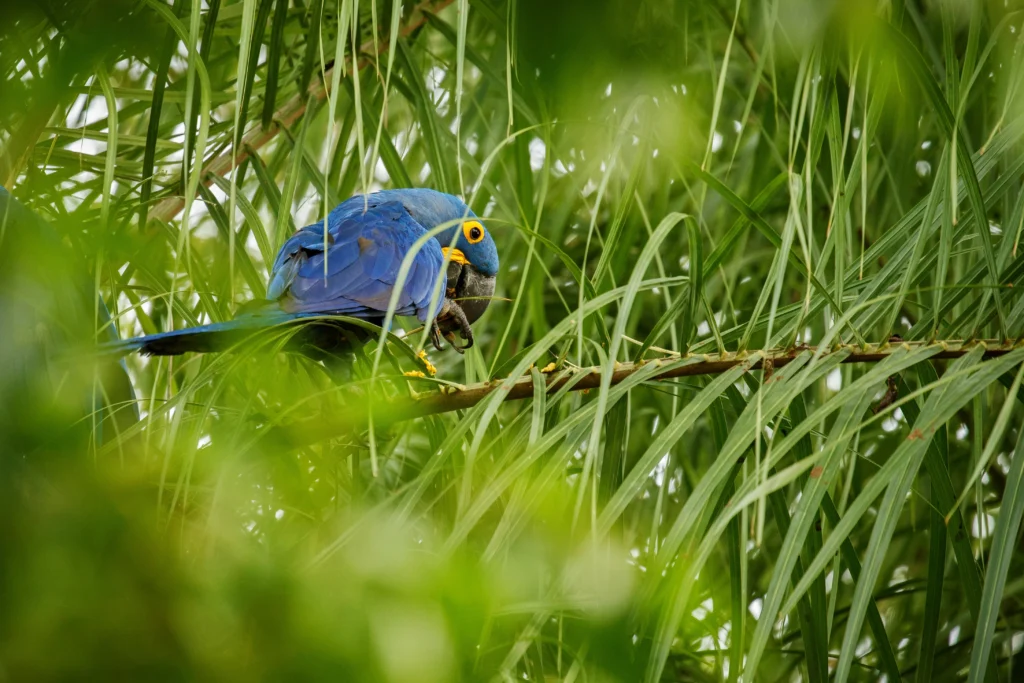
One of the most rewarding aspects of blue lovebird ownership is developing a strong bond with these intelligent, affectionate birds. Blue lovebirds are known for their capacity to form deep connections with their human caregivers when properly socialized.
Effective Socialization Techniques
The process of socializing a blue lovebird begins the moment the bird enters your home. Effective socialization includes:
- Allowing a short adjustment period in a quiet environment
- Speaking softly and moving slowly around new birds
- Offering treats from your hand once the bird seems comfortable
- Gradually increasing direct interaction time
- Using positive reinforcement for desired behaviors
- Respecting the bird’s boundaries and body language
Blue lovebirds raised by hand from a young age typically develop the strongest bonds with humans. However, even adult birds can become remarkably tame and affectionate with patient, consistent socialization efforts.
Understanding Blue Lovebird Body Language
Learning to interpret your blue lovebird’s body language is essential for building trust and avoiding stress. Key signals include:
Positive/Relaxed Signals:
- Gentle beak grinding (indicates contentment)
- Fluffed feathers at rest (relaxation)
- Head bobbing (often a friendly greeting)
- Regurgitation (a sign of strong bonding, though not always desirable)
- Relaxed wings held close to the body
Stress/Discomfort Signals:
- Rapid breathing or tail bobbing
- Pinned (constricted) pupils
- Crest or head feathers raised
- Lunging or aggressive beak movements
- Excessive screaming or loud alarm calls
By respecting these communication signals, you can develop a relationship based on mutual trust and understanding, allowing your blue lovebird’s unique personality to flourish.
Blue Lovebird Colors and Varieties: Beyond Basic Blue
While we’ve focused primarily on the standard blue lovebird, there are actually several stunning variations within the blue spectrum. Understanding these blue lovebird colors helps appreciation of the genetic diversity within these beautiful birds.
Common Blue Lovebird Varieties
The blue lovebird spectrum includes several distinctive variations:
- Sky Blue – The classic blue lovebird color, with a bright, medium-intensity blue that covers most of the body
- Cobalt Blue – A deeper, more intense blue with a slight purple undertone
- Mauve – A dusty, grayish-blue variation that results from specific genetic factors
- Violet-Factor Blue – An intense, vivid blue with pronounced violet highlights, particularly visible in certain lighting
- Turquoise – A blue-green intermediate color that results from incomplete expression of the blue gene
- White-Faced Blue – Combines the blue mutation with white face genetics for a striking contrast
Each of these blue lovebird mutation types has its own unique characteristics and breeding considerations. For collectors and enthusiasts, the subtle differences between these variations can become a fascinating area of study and appreciation.
Complementary Color Mutations
Blue lovebirds can also carry additional color mutations that create even more striking combinations:
- Pied Blue – Irregular patches of white feathers throughout the blue plumage
- Lutino Blue – Results in a white bird with red eyes (the blue gene affects yellow pigment, which is already absent in lutinos)
- Cinnamon Blue – Creates a softer, warmer blue tone with brown wing flights instead of black
- Dilute Blue – Produces a lighter, softer blue throughout the plumage
These combinations demonstrate the remarkable genetic plasticity of lovebirds and the artistry of dedicated breeders who work to develop and stabilize these beautiful variations.
Conclusion: The Enduring Appeal of Blue Lovebirds
The blue lovebird represents a perfect synthesis of natural avian beauty and human selective breeding. From their surprising genetic origins to their specific care requirements, unusual behavioral patterns, and significant market value, blue lovebirds stand out as particularly fascinating members of the pet bird community.
For those considering bringing a blue lovebird into their home, the journey promises to be rewarding. These birds offer not just striking visual appeal but also engaging personalities, the potential for deep bonds, and the satisfaction of providing specialized care for a somewhat rare pet. The blue lovebird lifespan of 10-15 years also means this is a companion for a significant portion of your life, making the commitment all the more meaningful.
Whether you’re captivated by the genetics behind blue lovebird mutation types, interested in blue lovebird breeding, or simply enchanted by blue lovebird photos showcasing their stunning plumage, these birds have something to offer every bird enthusiast. Their combination of beauty, intelligence, and affectionate nature continues to win the hearts of bird lovers across the United States and around the world.
As with any specialized pet, responsible ownership begins with education. By understanding the unique needs and characteristics of blue lovebirds, prospective owners can provide the care, environment, and interaction these remarkable birds deserve. In return, blue lovebirds offer years of companionship, beauty, and the daily joy of sharing your life with one of nature’s most colorful creations.
Resources for Blue Lovebird Enthusiasts
To learn more about blue lovebirds and their care, consider exploring these valuable resources:
- American Federation of Aviculture – Information on responsible bird breeding and care
- Avian Web – Comprehensive resources on lovebird varieties and care
- Association of Avian Veterinarians – Help finding qualified avian veterinarians
- PetsPump – More articles on lovebird care and other pet topics
- Lafeber Company – Nutrition information and quality bird foods
Remember that responsible blue lovebird ownership means being prepared for the financial commitment, time investment, and specialized knowledge these birds require. With proper care and attention, however, blue lovebirds reward their owners with years of companionship, beauty, and joy.
This article is for informational purposes only and does not substitute for professional veterinary advice. Always consult with an avian veterinarian for health concerns related to your blue lovebird.


